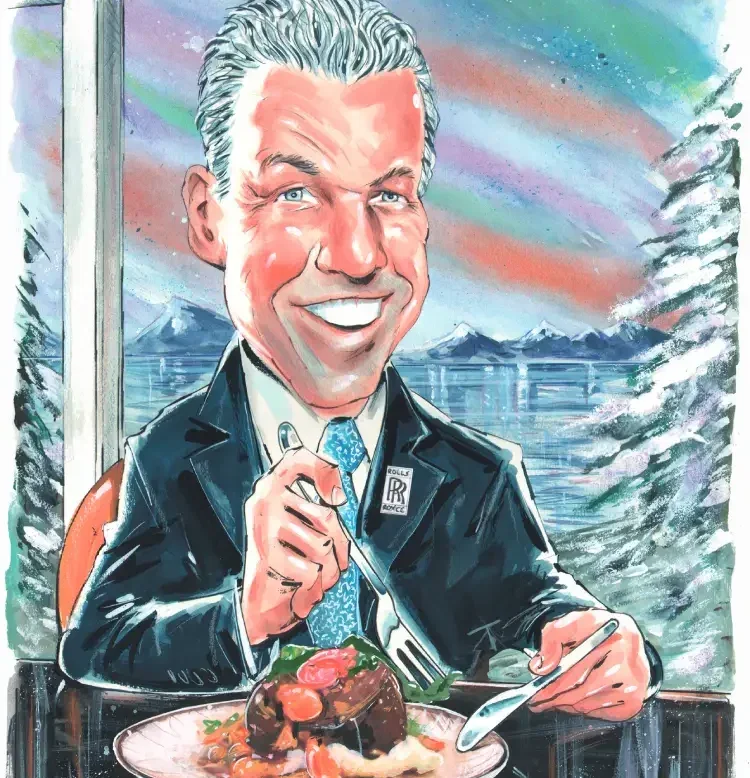
The last act of Torsten Müller-Ötvös as CEO of Rolls-Royce cars will also be his boldest. He’s launching the all-electric Rolls-Royce Spectre
The Hornavan Hotel in Swedish Lapland is a hostel for miners, loggers and hikers, but in winter it becomes more German than Swedish. Big German car manufacturers use the surrounding ice lakes and forest tracks just south of the Arctic Circle to test how their cars, especially the batteries, perform in temperatures as low as -40°C.
Which is why, on one of those mornings when it’s so cold you feel your bones might snap, I walk into the hotel’s wood-and-steel prefabricated dining room and take a seat next to the man who sells the best-known luxury product in the world:
Torsten Müller-Ötvös, chief executive of Rolls-Royce cars. He may be staying in the kind of hotel Rolls-Royce buyers would never check into, and eating in a place where all the diners are men and the chef seems to think chicken is a vegetable, but Müller-Ötvös has never been happier.
That’s because he’s out of the office doing what he loves most: driving. And he’s not test-driving any old car; he’s preparing for the launch of the all-electric Spectre, the eighth new model in his 12-year stint at the helm of the Goodwood-based marque.
‘We’re about to introduce the best coupe ever and the most important Rolls-Royce since the first Phantoms and Silver Ghosts took to the road,’ he says.
The Rolls Royce Spectre
Over moose and winter root vegetables, with knäckebröd (crispbread) on the side, and local berries for dessert, he explains the Spectre will not only power Rolls Royce into the electric era, it will make good on a 122-year-old promise.
In April 1900, Charles Rolls, the firm’s co-founder, predicted that since electric cars ‘are perfectly noiseless and clean, with no smell or vibration, they should become very useful when fixed charging stations can be arranged’.
Is the Spectre worth the century-plus wait? It’s enormous up close – imagine a two-door Ghost limousine – and comes with the option of 23-inch wheels. ‘You don’t want to ride in a little Rolls Royce,’
Müller-Ötvös says, chewing first his Teutonic vowels then his enormous moose steak, which is leaner than beef with a mild gamey flavour.
Underneath its striking camouflage that comprises quotes from Rolls’ partner Henry Royce, the Spectre retains the imposing Pantheon metal grille of all Rolls-Royces, topped off with a redesigned Spirit of Ecstasy mascot – despite the fact that electric cars don’t need grilles to cool the engine because electric engines don’t get hot.
‘The first electric Rolls-Royce deserves all the insignias of the brand,’ he says. In the cabin, the leather is as thick as icing on a Christmas cake, the carpets treacly, and the chrome-organ stop controls perfectly polished. But why kickstart a new era with a coupe, when an electric Cullinan SUV or Ghost limousine would probably sell better and deliver higher margins?
‘The first all-electric Rolls-Royce deserves a spectacular, emotional body. We’ve always had fond memories of our Phantom Coupé and when you see this car in full flesh, camouflage off, it is spectacular,’ says Müller-Ötvös, who has a weakness for coupes.
The wiry Düsseldorf-born executive, who has spent his entire career in the BMW Group, drives a Rolls-Royce Wraith (dark violet exterior and violet and black two-tone interior, since you ask). The size of the Spectre means it will require a vast lithium-cobalt battery, which will make it very heavy.
What will the range be – and the speed and power? ‘We’re not talking numbers and figures yet, but you will soon learn how powerful this car is and I’m sure you and our clients will love it,’ he demurs, speaking slowly and deliberately as you would if you were responsible for a brand that has next to no competition.
Observers reckon the Spectre will boast the 105kWh battery pack from the BMW i7 and iX that will power its two motors, one on each axle for four-wheel drive, delivering around 600bhp and 300 miles on a full charge. That’s not Tesla range, but the convenient truth, according to Müller-Ötvös, is that range is not hugely important to Rolls-Royce buyers.
‘Our customers use their cars going into cities, outside of cities, commuting around cities, so it’s rare that you’ll see long-distance drives, such as London to Edinburgh. All our buyers have charging stations at home and charging at their office.’ Rolls-Royce has been formally flirting with the idea of electric power for the past 11 years.
Its first effort, the 102 EX concept in 2011, was handsome and wafted along as only a Rolls-Royce can, but it had a range of precisely not very much. The 103EX in 2016 was an avant-garde interpretation of a radical, driverless future.
The Spectre combines the best of both – and is the only option if you ‘need’ a two-door Roller. The Wraith and Dawn convertible are sold out and will be discontinued when the final cars are delivered next year.
The Spectre will be followed by electric-only versions of the Phantom, the Ghost, the Cullinan, and a new convertible. The shift to EV will cost Rolls-Royce £2 billion. It’s a vast sum for a manufacturer that has committed never to produce more than 9,999 cars a year.
But Müller-Ötvös has no choice – governments around the world are banning sales of new petrol cars after 2030. He insists, however, that electric power fits the brand perfectly. ‘It is silent, very torquey, and offers the “waftability” – magic-carpet ride – we are famous for.’ By going fully electric years ahead of many other premium marques, he hopes to accelerate the brand’s drive to attract younger buyers.
As the rich get younger, thanks to the growing number of tech entrepreneurs in Asia and the US, Rolls-Royce customers have become so young that the marque now has the most youthful profile of any of the BMW brands, including Mini – with an average age of 43, down from 57 when Müller-Ötvös joined the firm.
The figure for Mini is 45. Going ‘green’ might make buyers feel a bit better about buying a luxury car that costs more than the average home in some countries, but are Rolls-Royces quite the right status symbol for these straitened economic times? ‘Over the last years I’ve seen an appetite to flaunt some money, to showcase and enjoy life,’ Müller-Ötvös says. ‘Covid changed how people see things.
saw how quickly life can end. That made people think, “Wow, I better live now.”’ Müller-Ötvös has the numbers to prove it. Rolls-Royce sold 5,586 cars last year, up 49 per cent on 2020 and the highest number in its history. Growth was led by China, which accounts for 30 per cent of sales. The US accounts for 30 per cent, Europe 20 per cent, and the Middle East and the rest of Asia 10 per cent each.

There is a one-year waiting list for any Rolls-Royce. ‘Rolls Royce has been profitable since I arrived,’ he adds. Müller-Ötvös’s full head of hair and weakness for Paul Smith sneakers belies his age (he’s 61) and the launch of the Spectre will be the final act in his ‘dream job… In a couple of years’ time my successor will take over – whoever that is.
Retirement comes.’ His departure is painful because ‘I love the UK, and especially British luxury brands. They are more charming than German brands. German brands are engineering brands and engineering tends to be cold. British brands are quirky, eccentric, bold.’
Reports of the decline in manufacturing in Britain have been much exaggerated, he adds. ‘The craftsmen and craftswomen in Britain are brilliant. If they need to improvise, they rip up the rule book, while many Germans would still be studying the rule book.’
However, one thing the Brits are not very good at is planning ahead. ‘If there is one thing that drives me mad about Brits, it’s the way you say, “We’ll cross the river when we get to it.” No German would ever say that.
A German plans three days before he gets to the river, so he can be sure he will make it. He also carries a second bridge, just in case the first does not work.’ The combination of British quirk and charm with German planning and process, however, makes ‘Brits and Germans a perfect fit’.
And the price of the Spectre, I ask, as we finish up our moose and move on to the berries? ‘£400,000, but our average price is £500,000 when all the bespoke extras are taken care of. You can take delivery next year.’ Only 123 years later than Charles Rolls had hoped.
Spear’s Magazine presents Spear’s 500 Live on 7 September. Find more information on NSMG.live.






